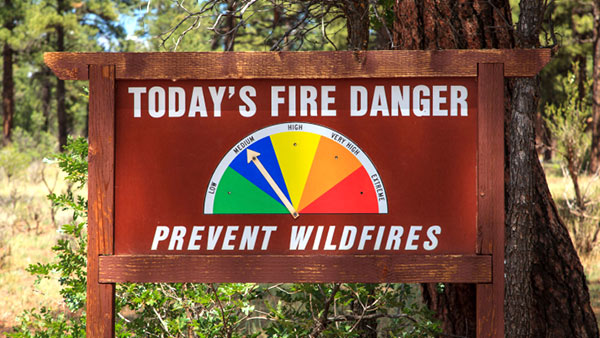Residents of areas vulnerable to wildfire need to remain on alert to changing conditions by monitoring the wildfire threat at the National Interagency Coordination Center.
Business and homeowners in woodland, brush-filled or remote areas can take precautions to protect your property against wildfire.
General Defense
There are some simple steps you can take to maximize protections against the dangers of wildfire:
- Talk to your local, independent agent to make sure you have the necessary limits and coverage enhancements in place
- Assess common fuel sources with your local fire department or a loss control representative – look for underbrush, branches and other combustibles.
- Create a financial first aid kit to identify your important documents, medical records and contracts, and store copies securely online and in a fire-protected container.
Structure
If you are building or updating a home or commercial building in an area prone to wildfires, you can select materials and construction methods to minimize your risk.
- Wood shake and shingle roofs are vulnerable to wildfire and are prohibited in some states. Consider fire-resistant roofing materials such as composite shingles, metal or copper.
- Contemplate nonflammable materials for outdoor-facing areas, including decks and windows.
- Cover all attic, eave and vent openings with noncorrosive metal wire mesh.
- Enclose areas that may accumulate flammable material, under and against the building.
- Remember that rubber mulch is also flammable and could allow fire an entry point to your building.
Perimeter
- Create a defensible space around your structure – approximately 100 feet on level ground and even further if the area is sloped. Make sure it is maintained and watered regularly.
- Remove all dead plants, trees, branches and debris. Trim several feet of spacing between trees if possible. Thin heavily pined areas. Prune tree limbs at least 6 feet off the ground. Remove branches that extend over the roof or are in close proximity to the building
- Keep grass trimmed short and, if possible, watered.
- Store gasoline, oily rags and other flammable materials in approved safety cans. Place cans in a safe location away from the base of buildings.
Upkeep
Periodic maintenance of existing structures is also important.
- Clear the roof, gutters, porches and decks of leaves, needles, branches and other debris.
- Make sure smoke detectors and fire extinguishers are functioning properly throughout your home or in your business.
- Verify that your outdoor water source and hose are functioning properly and can reach any area of the property.
Resources
For more detailed fire prevention tips, you can also visit the National Fire Protection Association’s Firewise website; read the NFPA’s tip sheet; the Occupational Safety and Health Administration’s wildfire response guidelines; and the Ready.gov website for more information on plans and response kits. It’s important to have a plan to reduce your risk as well as a plan to respond if a wildfire occurs in your area. We also have resources and posts collected on our Wildfires page.
Remember to consult with your independent insurance agent and local officials, and include your family or employees in your protection measures.
This loss control information is advisory only. The author assumes no responsibility for management or control of loss control activities. Not all exposures are identified in this article. Contact your local, independent insurance agent for coverage advice and policy service.

